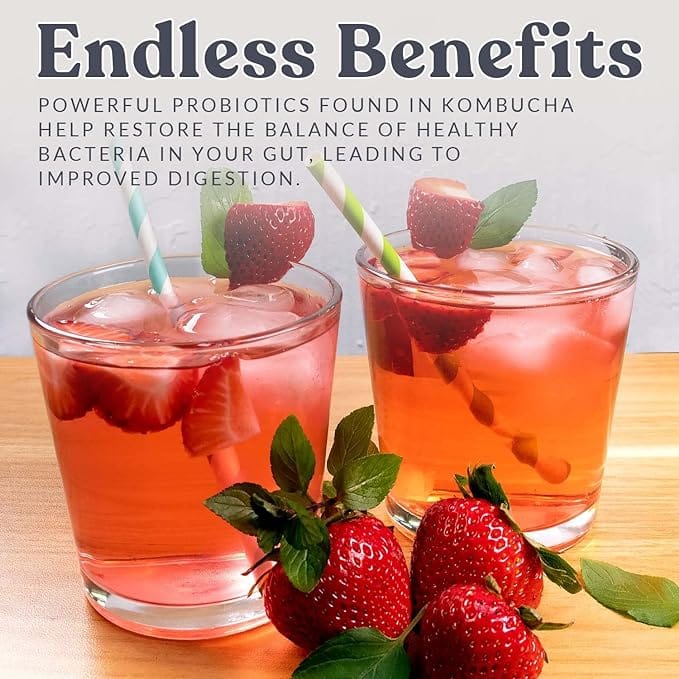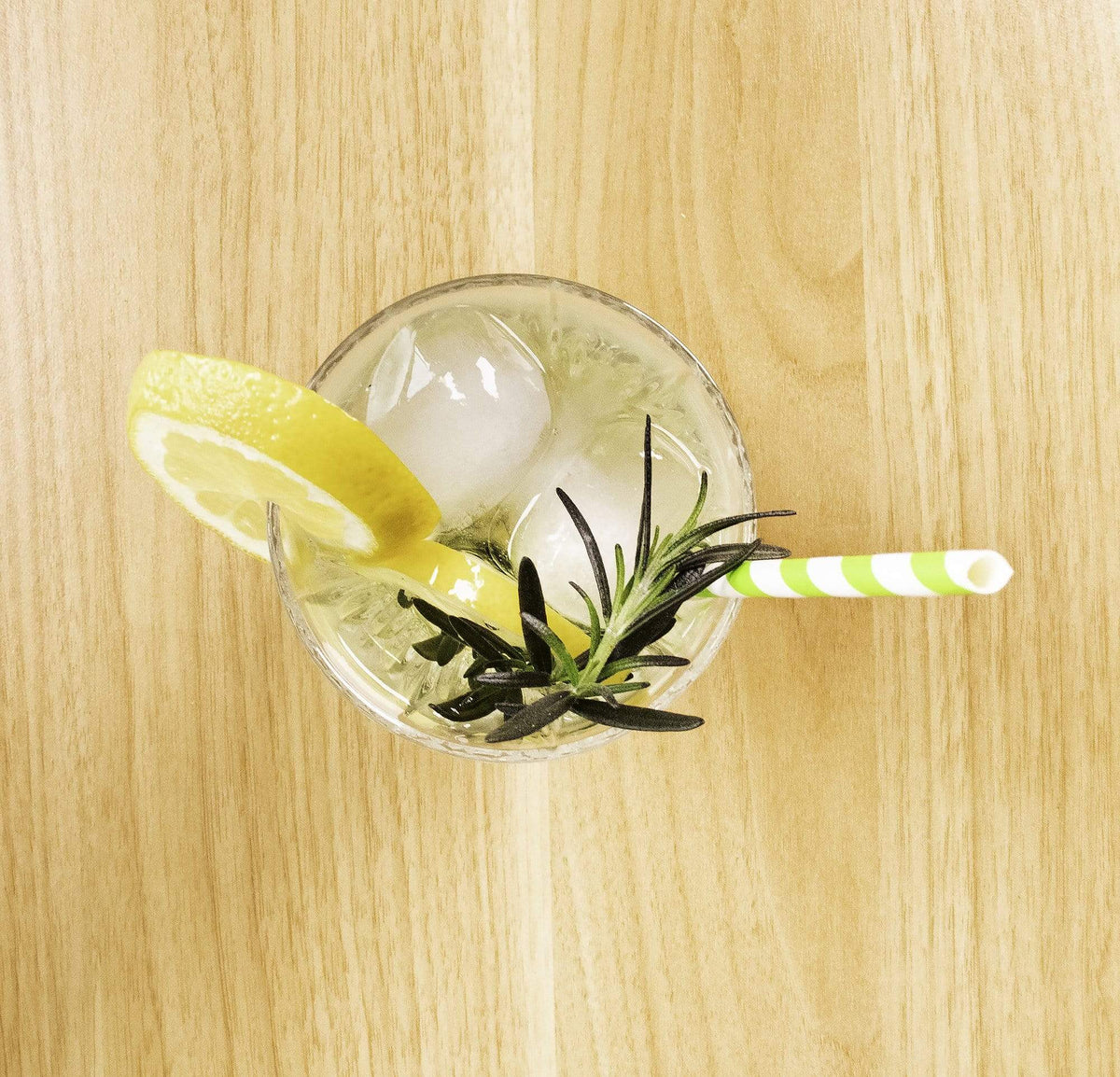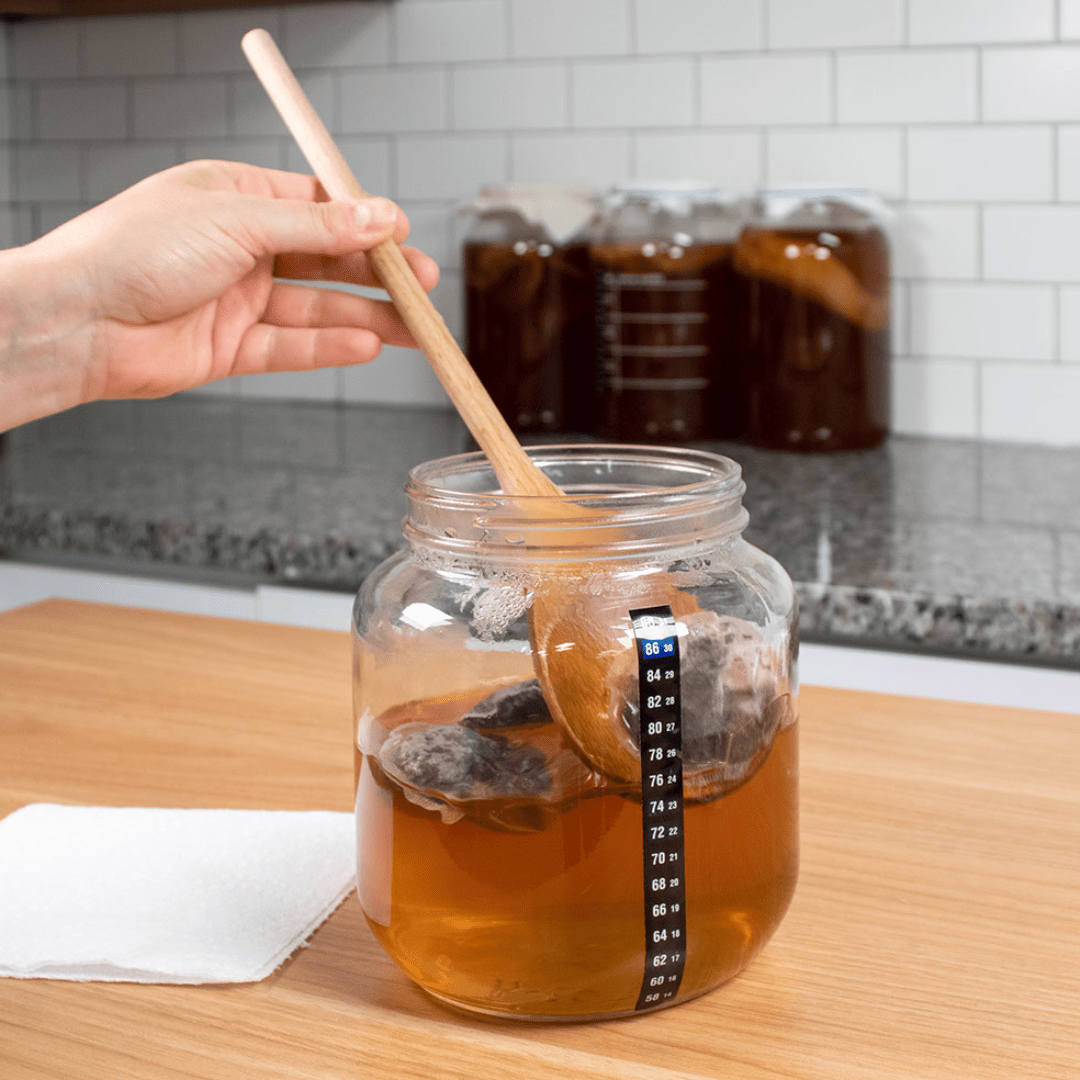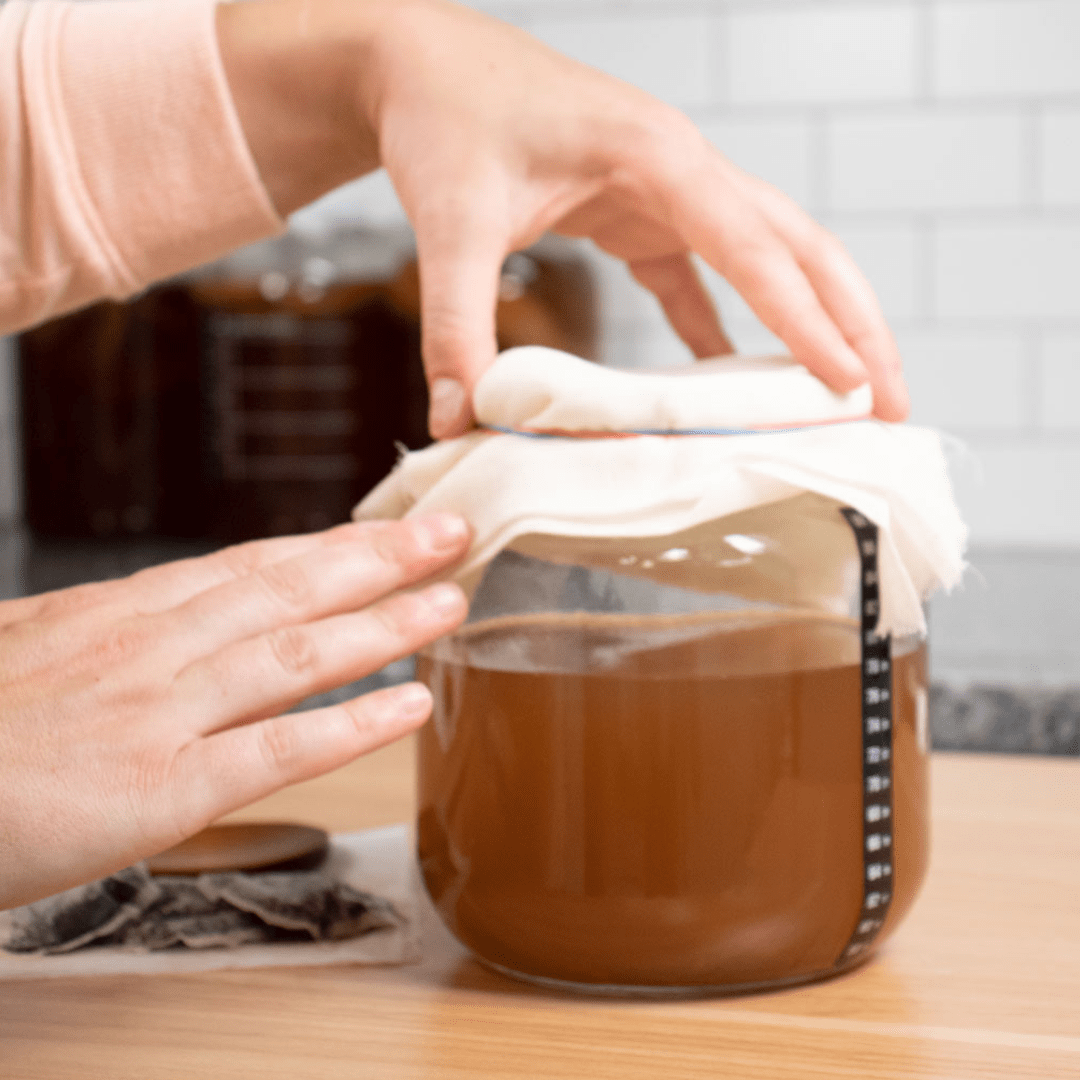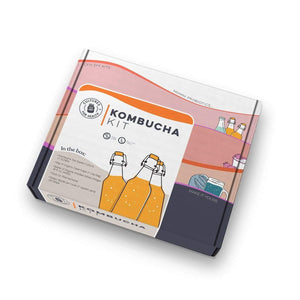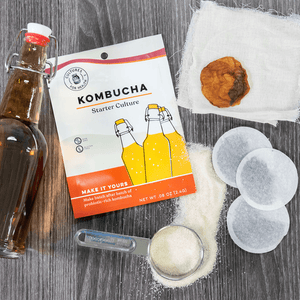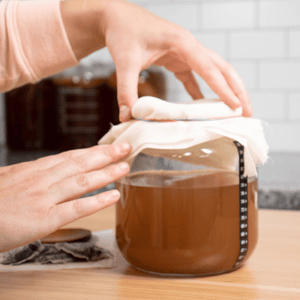
Around the world, people have been drinking fermented tea for many hundreds of years, calling it by various names and praising its probiotic benefits as well as its refreshing flavor.
Jump to a Section:
- What is Kombucha?
- The Kombucha SCOBY
- How Kombucha is Made
- What's in Finished Kombucha?
- Why Brew Kombucha at Home
WHAT IS KOMBUCHA?
Kombucha is an ancient fermented tonic made from sweetened tea. Once cultured, this effervescent beverage contains a host of beneficial bacteria, yeasts, and acids imparted to it by its kombucha mother culture, often referred to as a SCOBY.
Kombucha has a long history of consumption in Asia and Europe but in recent years it has gone somewhat mainstream. Many consume kombucha now for the many health and probiotic benefits it is touted for. Others simply enjoy the tangy, fizzy flavor of this fermented beverage.
So, what transforms plain, sweet tea into an effervescent, probiotic drink? The process of making kombucha all begins with a SCOBY.

Download our Kombucha Guide and Recipe book today to learn more about kombucha bacteria and yeast and how they can benefit your health. You'll also find delicious recipes for making your kombucha tea.
THE KOMBUCHA SCOBY
A kombucha SCOBY is one of five ingredients that go into brewing kombucha tea. SCOBY stands for symbiotic colony of bacteria and yeast. “Symbiotic” means that the bacteria and yeast strains live together in a complex, mutually supportive community, supporting and depending on each other. [1]
You may hear a SCOBY referred to as a mushroom because it resembles the smooth, thick body of a mushroom. The pancake-shaped disk is somewhat slimy and gelatinous in feeling. (Some might even say it resembles raw chicken.)
Not all kombucha SCOBYs contain the exact same strains of bacteria and yeast, but they generally all act in a similar way to create kombucha tea.
One thing all kombucha SCOBYs have in common is that they are a self-perpetuating culture. This means the SCOBY multiplies itself through the process of creating kombucha.
HOW KOMBUCHA IS MADE
The Science Behind Fermentation
Making kombucha is a simple process using very few ingredients, but there is a complex biological process happening to create that delicious beverage.
Kombucha Starter Kit
We won’t dive too deeply into details, but understanding some basic principles will help take the mystery out of what is a very simple process.
Kombucha is made through a symbiotic relationship. The SCOBY itself is a symbiotic culture, as mentioned above, in which bacteria and yeasts co-exist in harmony. Because that SCOBY is a living entity, it needs food and a proper environment to thrive.
A kombucha SCOBY’s food source is sweetened black tea. When you place a SCOBY into the prepared tea, it begins to consume the sugars and form another SCOBY, often referred to as a baby.

The other symbiotic relationship therefore exists between the SCOBY and the sweet tea. The SCOBY needs the tea to survive and kombucha cannot be made without the SCOBY. This process can take as little as a week, if it is warmer, and up to a month in cooler temperatures.
The by-products of this process are organic acids, a multiplication of the bacteria and yeasts within the sweetened tea, carbon dioxide (which is how kombucha becomes carbonated), a trace of alcohol, and B vitamins.
Commercial Kombucha Brewing Process
Many of the commercial kombucha brewing companies started off as homebrewers. When the market began to show a demand for kombucha twenty years ago, these homebrewers scaled up. G.T. Dave’s was one of the first commercial brewers to bring kombucha to the market and is still one of the largest commercial brewers today.
Commercial kombucha brewing is regulated by the government and as such there are restrictions on the brewing process. Alcohol content was a big concern in 2010, when bottles on market shelves were found to have a 2.5% alcohol content.
Many companies changed the way in which they brewed kombucha, either pasteurizing it or deviating from the traditional brewing practices to keep the alcohol content predictable.

PROBIOTICS: KOMBUCHA BACTERIA & YEAST
The specific bacteria and yeast strains in the kombucha are what make it act the way it does, and what produce the fizz and flavor of kombucha. Not all kombucha cultures will contain the exact same strains, but these are some that have been recorded in studies:
- Acetobacter [2][2][2][2][2][2] is an anaerobic bacteria that is unique to kombucha. It feeds on nitrogen that is found in tea and produces acetic acid and gluconic acid, as well as building the scoby.
- Zygosaccharomyces kombuchaensis [3] is a yeast strain that is unique to kombucha. It produces alcohol and carbonation as well as contributing to the mushroom body.
Kombucha also contains a variety of other nutrients, particularly various acids and esters that give the drink its characteristic tang and fizz. Included in these components is gluconic acid, which is the primary difference between the makeup of kombucha and the makeup of apple cider vinegar.
The actual bacteria, sugar, and acid content of kombucha depend on many factors, including the initial culture, the type of tea used, the type of sugar used, the strength of the tea, the type of water, the brewing time, the culturing temperature, and more. Due to the nature of kombucha, it is not possible to state an exact microbial composition for Kombucha. [1]
While different SCOBYs may vary in their exact makeup, what is common to all kombuchas is gluconic acid, acetic acid, and fructose. [2]

Caffeine Content
One question often asked is “How much caffeine is in kombucha?”. Given that kombucha is made with black tea which contains a fair amount of caffeine, this is an important question if you generally avoid caffeinated beverages.
There are a lot of different findings in this area that run the gamut from the caffeine is greatly reduced during the fermentation process to it isn’t reduced at all. One source, Dr. David Chappuis in his work The Green Tea Book, found that caffeine content of kombucha reduced by approximately 25% over a two-week brewing time. This could be extrapolated upon to assume that it would continue to decrease through longer brewing.
With many different findings from many different sources, it seems safe to say that there is some caffeine in the final brew, though most sources consider it to be a relatively small amount.
Alcohol Content
Like other fermented foods, kombucha does contain some alcohol as a by-product of the fermentation process. The alcohol content of kombucha is generally considered very low by most standards, especially when traditional brewing practices are kept.
Sugar Content
Kombucha starts as a very sweet tea and, over time through the brewing process, becomes more tart and less sweet. The sugar content can therefore be controlled by the amount of time it is allowed to brew. A longer brew of at least several weeks will contain much less sugar and much more organic acids.
Remember, too, that kombucha brewing is dependent on the temperature at which it cultures. Sugar content will vary with the seasons as well as the length of time it is allowed to culture for. For that reason, tasting the kombucha at various stages of the brew is the most reliable way to discern the sugar content and the length of brew time.

WHY BREW KOMBUCHA TEA AT HOME
Brewing kombucha at home has many advantages. For one, homebrewing practices are not regulated. This is particularly important for a raw, fermented beverage such as kombucha. The kombucha brewing process does not simply stop once the kombucha is removed from the original SCOBY. It continues to produce the bacteria, yeasts, acids, and trace amounts of alcohol even after refrigeration. When you brew at home, you can brew with traditional practices with no worry over regulations of the ever-changing final product.
Homebrewing also presents the advantage of controlling the ingredients - choose the sugar and tea you prefer based on your preference for quality and cost. Likewise, you can control the final sugar content by choosing to brew longer for a lower sugar beverage.
Homebrewing is more economical. While commercial kombucha can run anywhere from three to five dollars for a pint, homebrewed kombucha costs less than $.50 per bottle, on average.
Homebrewing kombucha is not simply a means of creating delicious fermented beverages, for some it is a hobby. Like other DIY projects, it allows for creativity in flavoring the kombucha for a second fermentation.
More than that, it allows you to dabble in the art of fermentation. With every batch of kombucha you can pass that culture on to a friend or family member or teach your own children the practice of fermentation.
WHAT'S NEXT?
Now that you know a little more about what makes up a kombucha SCOBY, make sure you have all the ingredients and supplies you need to get brewing. Then watch our How-To Video on making homemade kombucha to get started. You Can Do This!
Interested in learning about Kombucha bacteria and yeast? Download our Kombucha Guide and Recipe Book today!
SOURCES
1. Ai Leng Teoha,, Gillian Heard, Julian Cox.(2044). Yeast ecology of Kombucha fermentation. International Journal of Food Microbiology, 95(2), 119-126. doi:10.1016/j.ijfoodmicro.2003.12.020
2. Jayabalan, R., Malini, K., Sathishkumar, M., Swaminathan, K., & Yun, S. E. (2010). Biochemical characteristics of tea fungus produced during kombucha fermentation. Food Science and Biotechnology, 19(3), 843-847.
3. Kurtzman, C. P., Robnett, C. J. and Basehoar-Powers, E. (2001), Zygosaccharomyces kombuchaensis, a new ascosporogenous yeast from ‘Kombucha tea’. FEMS Yeast Research, 1: 133–138. doi: 10.1111/j.1567-1364.2001.tb00024.x















